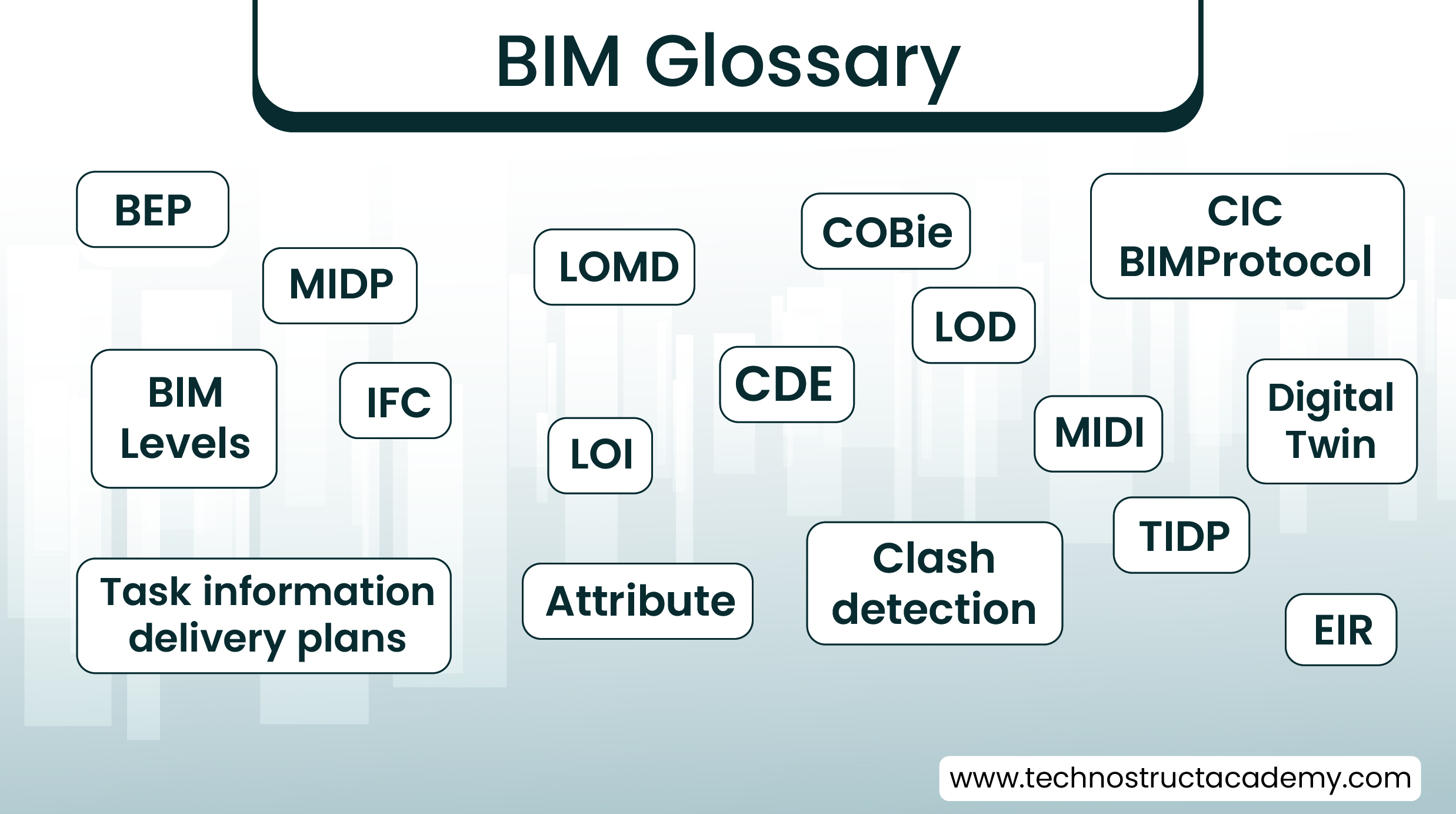Let us dive into Key BIM Glossary
Jul 11, 2023
Category: BIM / Digitization / Automation
SEO TSA

LET’S DISSECT THE COMMONLY USED TERMINOLOGIES IN BIM
In that case, we suggest that you review our BIM glossary, which contains the key terms that every professional in the current AEC market who wants to participate in decision-making should be familiar with. A comprehensive knowledge of vocabulary is necessary to be a successful BIM practitioner.
CDE – Common Data Environment
It is the central data repository necessary to carry out the BIM Level 2 information-sharing function. The CDE gathers, organizes, and disseminates pertinent, verified project documentation for interdisciplinary teams at the designated access level.
The CDE platform is often hosted on an external server that all project participants can access with the necessary rights. Information flow on the CDE platforms is automated. They also employ predetermined procedures for accepting, commenting on, and distributing documents.
EIR – Employer’s Information Requirements
A document outlining what the employer needs when ordering services. Levels of modeling detail, needs for training and competence, management systems, data transmission formats, etc. may all be included in these criteria.
BEP – BIM Execution Plan
It is a key investment document that suppliers create to satisfy EIR criteria (usually prior to signing a contract as Pre-contract BEP).
The master plan for providing project information that is tailored to the particular investment programme includes roles and responsibilities, rights, standards, methods, procedures, milestones, schedule, information flow strategies, conventions for the nomenclature of drawings, components, models, and attributes.
LOD – Level Of Detail
The level of detail (LOD) is used to define the required graphic content of the model at a particular stage of the project. As the project progresses, the components in the model will be delivered in more detail. For instance, in the case of interior doors, the model may start with a door represented by a simple cuboid, and then additional details will be added as the project progresses.
LOI – Level Of Information
The information level determines the non-graphical content of the model at particular stages of the project. As the project progresses, non-graphic details will increase. For doors at the start of a project, the cuboid representing the door will contain limited non-geographical data such as door classification. As the project develops, performance data such as fire resistance, and subsequently manufacturer data, datasheet, etc., will be provided.
LOMD – Level of Model Definition
The combination of LOD and LOI is known as LOMD – Level of Model Definition – meant to define the details required in a model at different project stages, both graphical and non-graphical.

BIM Levels
BIM has four levels (0-3), with each level representing increased ‘BIM maturity’, or the increased ability to exchange information digitally within the supply chain. Building information modeling levels are a universal understanding of what criteria are required to be BIM-compliant.
. Level 0: Level 0 entails no collaboration, and only 2D CAD drafting is used. Communication is done via paper and basic prints.
. Level 1: Level 1 BIM is a combination of 3D CAD and 2D for drafting. By cross-referencing techniques, users see efficiency and savings. Data and documents are shared via a common data environment. Each stakeholder or contractor maintains their own data and documents.
. Level 2: Working at Level 2 BIM, the goal is better collaboration and higher accuracy of information. Each level of planning, design, and construction is responsible for the development of each BIM.
. Level 3: With Level 3 BIM, data is open and available for all involved on one platform in a common format.
COBie – Construction Operation Building information exchange
A standard of documentation containing data to manage an object in the form of a spreadsheet. It is filled in depending on the project stage. The data in the worksheet includes information on the equipment of the facility along with information regarding each piece of equipment (technical and operational parameters, origin, price, warranty period, date of installation, spare parts lists, inspection dates, etc.).
IFC – Industry Foundation Classes
Industry Foundation Classes is a standard used in the construction sector for transmitting object-based building or infrastructure information from one computer system to another.
CIC BIM Protocol
The CIC BIM Protocol is a contract document for use with any standard building contract. It focuses on professional indemnity insurance issues. An identical CIC Protocol must be issued to each party contributing to the BIM.
Clash detection
In design terms, a clash occurs when components of different disciplines or services that make up a built asset are not spatially coordinated and conflict. In a BIM process, these clashes can be spotted more easily during the design phase of a project ahead of work starting on site.
Digital Twin
Also referred to as digital shadow, digital replica, or digital mirror – It is simply the digital representation of a physical asset.
TIDP – Task information delivery plans
Federated lists of information deliverables by each task team, including format, date, and responsibilities. Each task team is responsible to compile its own TIDP to assist in the development of the Master Information Delivery Plan (MIDP).
MIDP – Master Information Delivery Plan
Primary plan for when project information is to be prepared, by whom and using what protocols and procedures, incorporating all relevant task information delivery plans (TIDPs).
MIDI – Master Information Document Index
Index specifying a detailed list of the deliverables for a project; for a model, sub-models, documents, and data also allocating responsibility to deliver and the programme for delivery of a project supply chain.
Attribute
An attribute is a unit of data that describes a particular characteristic of an entity.







